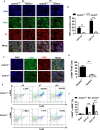GSDMD-dependent neutrophil extracellular traps promote macrophage-to-myofibroblast transition and renal fibrosis in obstructive nephropathy
- PMID: 35941120
- PMCID: PMC9360039
- DOI: 10.1038/s41419-022-05138-4
GSDMD-dependent neutrophil extracellular traps promote macrophage-to-myofibroblast transition and renal fibrosis in obstructive nephropathy
Abstract
Renal fibrosis is a common consequence of various progressive nephropathies, including obstructive nephropathy, and ultimately leads to kidney failure. Infiltration of inflammatory cells is a prominent feature of renal injury after draining blockages from the kidney, and correlates closely with the development of renal fibrosis. However, the underlying molecular mechanism behind the promotion of renal fibrosis by inflammatory cells remains unclear. Herein, we showed that unilateral ureteral obstruction (UUO) induced Gasdermin D (GSDMD) activation in neutrophils, abundant neutrophil extracellular traps (NETs) formation and macrophage-to-myofibroblast transition (MMT) characterized by α-smooth muscle actin (α-SMA) expression in macrophages. Gsdmd deletion significantly reduced infiltration of inflammatory cells in the kidneys and inhibited NETs formation, MMT and thereby renal fibrosis. Chimera studies confirmed that Gsdmd deletion in bone marrow-derived cells, instead of renal parenchymal cells, provided protection against renal fibrosis. Further, specific deletion of Gsdmd in neutrophils instead of macrophages protected the kidney from undergoing fibrosis after UUO. Single-cell RNA sequencing identified robust crosstalk between neutrophils and macrophages. In vitro, GSDMD-dependent NETs triggered p65 translocation to the nucleus, which boosted the production of inflammatory cytokines and α-SMA expression in macrophages by activating TGF-β1/Smad pathway. In addition, we demonstrated that caspase-11, that could cleave GSDMD, was required for NETs formation and renal fibrosis after UUO. Collectively, our findings demonstrate that caspase-11/GSDMD-dependent NETs promote renal fibrosis by facilitating inflammation and MMT, therefore highlighting the role and mechanisms of NETs in renal fibrosis.
© 2022. The Author(s).
Conflict of interest statement
The authors declare no competing interests.
Figures








Similar articles
-
Caspase-11/GSDMD contributes to the progression of hyperuricemic nephropathy by promoting NETs formation.Cell Mol Life Sci. 2024 Mar 4;81(1):114. doi: 10.1007/s00018-024-05136-z. Cell Mol Life Sci. 2024. PMID: 38436813 Free PMC article.
-
Tanshinone IIA reduces tubulointerstitial fibrosis by suppressing GSDMD-mediated pyroptosis.Pharm Biol. 2025 Dec;63(1):364-373. doi: 10.1080/13880209.2025.2498166. Epub 2025 May 7. Pharm Biol. 2025. PMID: 40331369 Free PMC article.
-
P2Y12 inhibitor clopidogrel inhibits renal fibrosis by blocking macrophage-to-myofibroblast transition.Mol Ther. 2022 Sep 7;30(9):3017-3033. doi: 10.1016/j.ymthe.2022.06.019. Epub 2022 Jul 5. Mol Ther. 2022. PMID: 35791881 Free PMC article.
-
The role of the macrophage-to-myofibroblast transition in renal fibrosis.Front Immunol. 2022 Aug 5;13:934377. doi: 10.3389/fimmu.2022.934377. eCollection 2022. Front Immunol. 2022. PMID: 35990655 Free PMC article. Review.
-
Transformation of macrophages into myofibroblasts in fibrosis-related diseases: emerging biological concepts and potential mechanism.Front Immunol. 2024 Sep 25;15:1474688. doi: 10.3389/fimmu.2024.1474688. eCollection 2024. Front Immunol. 2024. PMID: 39386212 Free PMC article. Review.
Cited by
-
The emerging role of neutrophil extracellular traps in ulcerative colitis.Front Immunol. 2024 Aug 7;15:1425251. doi: 10.3389/fimmu.2024.1425251. eCollection 2024. Front Immunol. 2024. PMID: 39170617 Free PMC article. Review.
-
Regulated cell death pathways in kidney disease.Nat Rev Nephrol. 2023 May;19(5):281-299. doi: 10.1038/s41581-023-00694-0. Epub 2023 Mar 23. Nat Rev Nephrol. 2023. PMID: 36959481 Free PMC article. Review.
-
Neutrophil extracellular traps and long COVID.Front Immunol. 2023 Sep 27;14:1254310. doi: 10.3389/fimmu.2023.1254310. eCollection 2023. Front Immunol. 2023. PMID: 37828990 Free PMC article. Review.
-
SREBP1c-Mediated Transcriptional Repression of YME1L1 Contributes to Acute Kidney Injury by Inducing Mitochondrial Dysfunction in Tubular Epithelial Cells.Adv Sci (Weinh). 2025 Feb;12(6):e2412233. doi: 10.1002/advs.202412233. Epub 2024 Dec 16. Adv Sci (Weinh). 2025. PMID: 39680752 Free PMC article.
-
Role of gasdermins in chronic kidney disease.Front Immunol. 2025 Apr 1;16:1557707. doi: 10.3389/fimmu.2025.1557707. eCollection 2025. Front Immunol. 2025. PMID: 40236694 Free PMC article. Review.
References
Publication types
MeSH terms
Substances
LinkOut - more resources
Full Text Sources
Medical
Molecular Biology Databases

